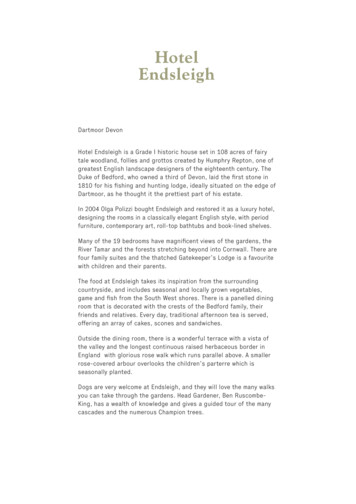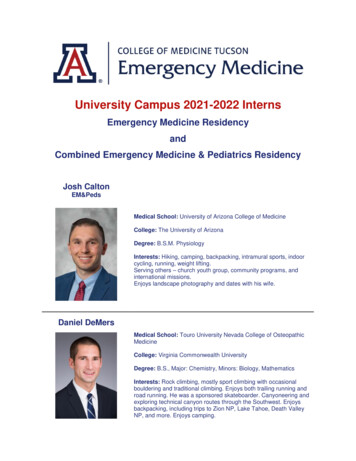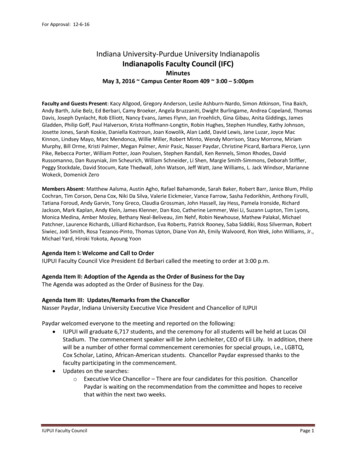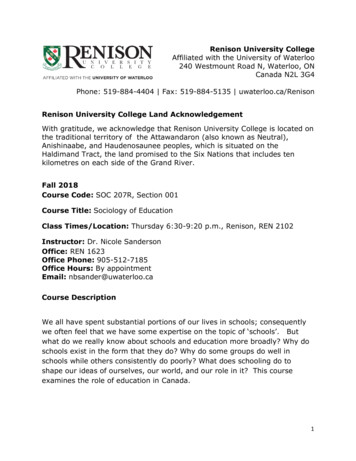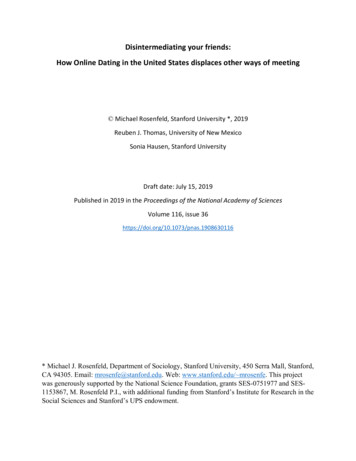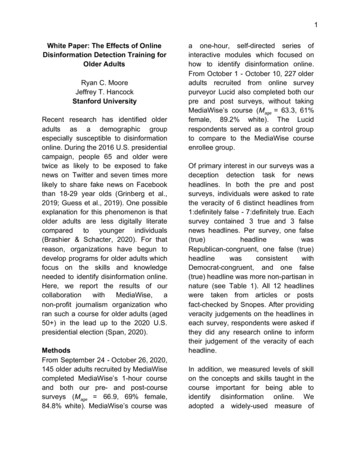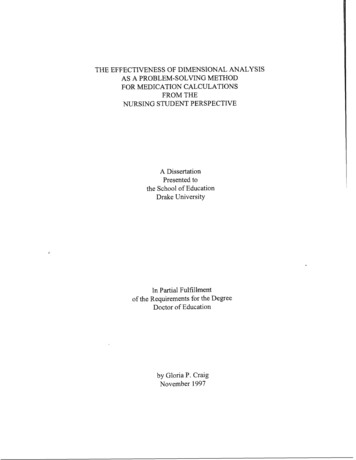
Transcription
THE EFFECTIVENESS OF DIMENSIONAL ANALYSTSAS A PROBLEM-SOLVING METHODFOR MEDICATION CALCULATIONSFROM THENURSING STUDENT PERSPECTIVEA DissertationPresented tothe School of EducationDrake UniversityIn Partial FulfilImentof the Requirements for the DegreeDoctor of Educationby Gloria P. CraigNovember 1997
THE EFFECTIVEl\TESS OF DIMENSIONAL ANALYSISAS A PROBLEM-SOLVING METHODFOR MEDICATlON CALCULATIONSFROM THENURSING STUDENT PERSPECTIVEby Gloria P. CraigNovember 1997Approved by Committee:Sandra L. SellersDean of the School of Education
Table of ContentsPageList of TablesChapter1. INTRODUCTIONOverview of the ProblemPurpose of the StudyDefinition of TernsOverview of the Theoretical FrameworkSignificance to Nursing2. REVIEW OF THE LITERATURETheoretical FrameworkRelated LiteratureSummary3. h4ETHODOLOGYResearch DesignSample and Sampling PlanData Collection InstrumentsDate Collection ProceduresProtection of Human SubjectsSummary4. ANALYSIS OF DATA
Description of the SampleAnalysis of lnfomatio lSutnmapy5. SUMMARY, DISCUSSION, AND RECOMMENDATIONSDiscussionLimitat ionsRecornendations for Future ResearchImplications for Advanced Nursing PracticeREFERENCESAPPENDICESA. Demographic ToolB. Cover LetterC. Student Informed ConsentD. Closed-ended Questionnaire
THE EFFECTIVENESS OF DlMENSIONAL ANALYSISAS A PROBLEM-SOLVING METHOD FOR MEDICATION CALCULATIONSFROM THE NURSING STUDENT PERSPECTIVEAn abstract of a Dissertation byGloria P. CraigNovember 1997Drake UniversityAdvisor: Charles S, GreenwoodThe problem.The nursing literature has identified that many nurses experience difficulty incalculating medication calculation problems. Chemistry educators have adopted amethod, dimensional analysis, that is not only easier to learn but also reduces errors whena mathematical conversion is required. The purpose of this qualitative study was toevaluate the effectiveness of dimensional analysis as a problem-solving method formedication calculations from the perspective of nursing students. Specifically, the studyanswered the grand-tour question, ''What perceptions do nursing students have regardingthe effectiveness of dimensional analysis as a problem-solving method for medicationcalculations?" Based on the nursing literature, four sub-questions also were inctudedregarding mathematical, conceptual, and cognitive deficiencies and mathematical anxietylevels of nurses and nursing students.Procedures.A purposefbl sampling was utilized with 27 nursing students enrolled in a threeyear diploma nursing education program from a hospital-based school of nursing locatedin central Iowa. To establish trustworthiness of the study, triangulation of the data wasaccomplished through the use of participant observation, one-to-one, open-endedinterviews, and a closed-ended questionnaire allowing eonclusions to be draw frommultiple referents. Six nursing students requesting additional tutoring were chosen toparticipate in one-to-one, open-ended interviews based on the criteria for critical casesampling permitting maximum application of information.Findings.Data obtained from the nursing students provided themes and conceptual patternsregarding the effectiveness of dimensional analysis as a problem-solving method formedication calculations. Nine emerging themes were obtained from the data exmplesprovided by the six nursing students during the open-ended interviews and categorizedinto three major conceptual patterns.Closed-ended questionnaires were answered by 27 nursing students. All of thenursing students strongly agreed and agreed ( I 00%) that dimensional analysis improvedtheir mathematical calculation abilities and conceptual abilities, 92.6% strongly agreedand agreed that it improved their cognitive abilities, and 77.8% strongly agreed andagreed that it reduced their anxiety levels when solving medication calculation problems.
Conclusions.In this study, nursing students identified that dimensional analysis was meffective problem-solving method for medicatioi calculations that assisted them inimproving their mathematical, conceptual, and cognitive abilities, as well as decreasetheir anxiety levels. Dimensional analysis was found to be a successful problem-solvingmethod for both right-brain and left-brain learners because of the ability to be visualizedand followed in a logical manner with an explicit step-by-step approach.Recommendstions.The positive fmdings from this study certainly warrant further quantitative andqualitative research using dimensional analysis as a problem-solving method formedication caIculations with other nursing students, students in other disciplines, andpracticing nurses. Regardless of whether dimensionaI analysis is used in education orpractice, it remains an avenue to be considered by schools of nursing, hospitals, or otherinstitutions when the goal is competence in medication cdcuIation abilities, reduction ofmedication errors, and above all adherence to the code "do no harm."
TablesTablePage1. Summary of Demographic Characteristics of the Sample412. N130 Participant Observation Data443. N130 Video Observation Data454. N230 Participant Observation Data465. N230 Video Observation Data476. W330 Participant Observation Data487. N330 Video Observation Data498. Student Perceptions Regarding the Effectiveness ofDimensional Analysis519. Data Examples, Themes, and Conceptual Patterns fromOpen-ended Interviews5310. Student Responses Regarding Anxiety Related to Complexity65of Problems and Patient Safety11. Student Responses Regarding Ratio-and-Proportion6712. Data from the Closed-ended Questionnaire Regardingthe Sub-Questions6913. Data from the Closed-ended Questionnaire RegardingTeaching Strategy as outlined in the Textbook7014. Data from the Closed-ended Questionnaire RegardingMusic, Color, and Peripheral Learning Charts72
Chapter 1INTRODUCTIONOverview of the ProblemEvery nurse must know and practice the five rights of drug administration: theright drug, the right dose, the right route, the right time, and the right patient. Althoughnurses may be able to identify the right drug, route, time, and patient, the right doserequires mathematical, conceptual, and cognitive skills that may pose difficulty for someindividuals and may be compounded by mathematical anxiety related to a"mathophobia."To investigate medication calculation errors, Bindler and Bayne (1991) conducteda descriptive research study using a convenience sample of 110 registered nurses fromfour western states. They concluded that 8 1% of the registered nurses were unable tocalculate medication doses at a 90% level of proficiency on a 20-item medicationcalculation test. In addition, they found that 43.6% of the test scores were below the 70%level of proficiency. The investigators suggested that this unsatisfactory performancelevel should be a major concern for nurse educators and proposed that the most effectiveway to improve the mathematical calculation abilities of registered nurses would be tointegrate a specific problem-solving methodology into nursing curricula.Nursing education programs attest that they graduate safe, first line practitioners.Some researchers asserted, however, that this may be a misconception (Bindler & Bayne,1991). In a previous descriptive study conducted by Bindler and Bayne (1984), the basicmathematical skills of 741 junior baccalaureate nursing students were tested. Bindler andBayne reported that from 9% to 38% of the student groups tested were unable to pass all
parts of the Mathematics Proficiency Exam at the 70% level of proficiency. The authorsconcluded that a substantial number of the nursing students did not possess the basicmathematical abilities necessary to function as registered nwses. They stronglyrecommended that schools of nursing take an active role in identifying these students andfinding methods to improve their mathematical abilities.Although much of the research has been focused on the mathematical orcomputational skills of nursing students, Blais and Bath (1992) conducted a quantitativestudy to analyze the dosage calculation errors of nursing students from conceptual,mathematical, and measurement perspectives. They obtained a convenience sample of 66nursing students enrolled in an upper-division baccalaureate nursing program at a largepublic university.Blais and Bath focused on determining how many students lacked the skills toaccurately calculate drug dosages on a 20-item medication dosage calculationexamination and what type of error occurred most often including the frequency. Theresults revealed that 89% of the students did not perform at a 90% level. Conceptualerrors (set-up of the problem) were the most frequent type of mistake in 56% of thoseproblems missed. Errors involving mathematical deficiencies occurred in 19% of theproblems and measurement errors (converting between different measurement systems)occurred in 13% of the problems. Bath and Blais concluded that, although students dohave difficulty with mathematical and measurement deficiencies, the majority of thedeficiencies involve conceptual difficulties. They recommended that schools of nursingfocus not only on assisting the students with problem-solving strategies to conceptualize
the dosage calculation problem, but also to be consistent throughout the curriculum withthe type of formula the students are instructed to use.Using a pretest/post-test quantitative design to examine mathematical abilities,Ptaszynski and Silver (198 1) identified that the problem of poor calculation skills existsin other nursing programs. They found that nursing students entering baccalaureatenursing programs also have difficulty with dosage calculation because of a decline inSAT scores and varying degrees of mathematical background. They speculated that giventhese two variables along with the unit dose system used for medication administration,the problem of poor calculation skills is only compounded.In an attempt to rectify the situation, Ptaszynski and Silver (1981) iiltroducedposology (the study of dosage calculations) in an orderly, systematic fashion into anintegrated cmiculum through use of self-learning packets. The self-learning packetcontained specific terminal objectives and was developed for the first level nursingstudents focusing on the cognitive learning levels of knowledge, comprehension andapplication, using ratio-and-proportion as a mathematical problem-solving method.Ptaszynski and Silver (1981) administered a pretest during the first week of thesemester before any formal medication education. The post-test was administered afterthe conclusion of the posology module. Of the 77 nursing students included in the study,the results of the pretest included a mean score of 52% with a range of 33% to 8 1% ascompared to the results of a post-test mean score of 92.7% with a range of 76% to 100%.The study revealed that an organized problem-solving method to resolve medicationproblems can effectively increase the mean score from pretest to post-test. A high-level of
acceptance of the posology program was determined through written and verbalevaluative feedback from faculty and students. The result of this acceptance led to thedevelopment of a second-level posology course focusing on the calculation andadnlinistration of intravenous solutions.Historically, it has been reported that females experience higher levels ofmathematical anxiety than their male counterpart (Betz, 1978). Although a limitedamount of research exists in the nursing literature regarding mathematical anxiety,Hendel and Davis (1978) suggested a desensitization program as a means of loweringanxiety and improving performance. A computer-assisted instruction program developedby Timpke and Janney (1 98 1) provided students with the opportunity to work in privacyand at their own speed which decreased levels of anxiety and increased confidence.Fulton and O'Neill(1989) suggested that nurse educators should no longer assume thatfemale students are mathematically challenged and therefore possess high levels ofanxiety. On the other hand, Pozehl (1996) concluded that nursing students do suffer frommathematical anxiety and need a learning environment that is structured to help themattain a positive attitude toward mathematics.Information obtained from the nursing literature identified that medication errorsdo occur related to mathematical calculation deficiencies, however, the educationalliterature of another discipline offered a possible solution to the problem of mathematicalcalculation deficiencies. Goodstein (1983) established that a majority of chemistrystudents were deficient in their ability to deal with the quantitative aspects of subjectmatter. In an effort to improve the quantitative abilities of chemistry students, the
chemistry educators utilized a problem-solving method called dimensional analysis (alsocalled factor label method, conversion-factor method, units analysis, and quantitycalculus). Coodstein expressed that even though the ratio-and-proportion method was atone time the primary problem-solving method, it has been largely replaced by adimensional analysis approach in most introductory chemistry textbooks.Dimensional analysis was identified in chemistry textbooks as a problem-solvingmethod as early as 1938. Frey (1938) defined dimensional analysis but did notspecifically explain how this method could be used to solve chemistry problems. Johnson(1969) defined dimensional analysis and described why this problem-solving methodshould be used to solve chemistry problems. He did not explain, however, how thismethod could be used to solve chemistry problems. Goodstein (1983) describeddimensional analysis as a problem-solving method that is very simple to understand,reduces errors, and requires less conceptual reasoning power to understand than does theratio-and-proportion method. She stated that this method condenses multi-step problemsinto one orderly extended solution.Hein (1983) described dimensional analysis as a useful method for solving avariety of chemistry, physics, mathematics, and daily life problems. He identified thatdimensional analysis is often the problem-solving method of choice because it provides asystematic, straightforward way to set up problems; gives a clear understanding of theprinciples of the problem; helps the learner to organize and evaluate data; and assists inidentifying errors in that unwanted units are not eliminated if the setup of the problem isincorrect.
Peters (1986) identified dimensional analysis as a method used for solvii gnotonly chemistry problems but also a variety of other mathematical problems that requireconversions. He described dimensional analysis as a method that can be used whenevertwo quantities are directly proportional to each other and one quantity must be convertedto the other using a conversion factor or conversion relationship. Once the given quantityis identified, the unit path (the series of unit conversions necessary to achieve the answer)is established. He summarized the problem-solving method of dimensional analysis asfollows:Problem: 3 yards How many inches?1. Begin with the given quantity.Example: 3 yards2. Establish the unit path from the given quantity to the wanted quantity, selecting theequations which will be used as conversion factors.Example: 1 yard 3 feetExample: 1 foot 12 inches3. Write the setup for the problem, multiplying and dividing in a logical sequencethrough each step of the unit path. Given quantity x (One or more conversion factors) Wantedquantity.Example: 3 yards How many inches?3 yards x 3 feet x 12 inches1 yard1 footNote that every conversion factor is a ratio of units which equals one.
4- Cancel units to be certain that the setup gives an answer expressed in h e correct units.Yards cancel. Feet cancel. Inches remain as the desired unit.Exampie: 3 yards x 3 feet x 12 inches I yard1 foot5. Multiply the numerators, multiply the denominators, and divide the product of thenumerators by the product of the denominators to provide the numerical value of theanswer.Example: 3 yards x 3 feet x 12 inches 108 inchesI yard1 footAlthough there exists a paucity of research in the nursing literature regardingdimensional analysis, Craig (1993) conducted a quasi-experimental research study toexamine whether the use of dimensional analysis would improve the medication dosagecalculation abilities of nursing students. Specifically, the study compared the medicationdosage calculation abilities of 30 diploma nursing students (experimental group) whowere taught dimensional analysis with the medication dosage calculation abilities of 29associate-degree nursing students (control group) who were taught the traditionalproblem-solving methods of ratio-and-proportion or desired dose/dose on hmd. Todetemine if the increased level of improvement between the pretest and post-test scoresof the experimental group was significantly greater than the control group, anindependent t-test of the mean differences between the pretestlpost-test scores of theexperimental and control groups was applied. A statistically significant difference in thelevel of improvment was found between the two groups @ .00001). The findings of the
study support the use of dimensional analysis as an effective problem-solving method toassist nwsing students in developing the mathematical and conceptual skills to accuratelycalculate medication dosages and ensure the safe administration of medications.The nursing literature has identified that many nurses experience difficulty incalculating medication doses. Chemistry educators have adopted a method that is not onlyeasier to learn but also reduces errors when some type of mathematical conversion isrequired. Nurse educators should be interested in the use of dimensional analysis as amethod to improve the mathematical abilities of their students. The question, however,still remains as to whether nursing students using dimensional analysis perceive animprovement in their mathematical, conceptual, and cognitive abilities as well as adecrease in their anxiety levels.Purpose of the StudyThe pulpose of this qualitative study was to evaluate the effectiveness ofdimensional analysis as a problem-solving method for medication calculations from theperspective of nursing students. Specifically, the study answered the grand-tour question,"What perceptions do nursing students have regarding the effectiveness of dimensionalanalysis as a problem-solving method for medication calculations?" Based on the nursingliterature regarding deficiencies in basic mathematical skills, medication calculationerrors, conceptual and measurement problems, and mathematical anxiety levels, four subquestions also were researched:1.perceptions do nursing students have regarding dimensional analysis and theirmathematical calculation abilities?
2. What perceptions do nursing students have regarding dimensional analysis and theirconceptual abilities?3. What perceptions do nursing students have regarding dimensional analysis and theircognitive abilities?4. What perceptions do nursing students have regarding dimensional analysis and theiranxiety levels?Definition of TermsThe terms used for this study were defined as follows:Dimensional analysis - Dimensional analysis was defined as a problem-solvingmethod that can be used to calculate medication dosage problems whenever twoquantities are directly proportional to each other and one quantity must be converted tothe other using a conversion factor or conversion relationship.Nursing students - Nursing students were defined as those students enrolled in athree-year diploma nursing program located in central Iowa.Mathematical abilities - Mathematical abiIities were defined as those abilitiesconcerned with mathematics that are very precise and accurate.Conce tualabilities - Conceptual abilities were defined as the ability to set up amathematicai problem in a logical man
A purposefbl sampling was utilized with 27 nursing students enrolled in a three- year diploma nursing education program from a hospital-based school of nursing located in central Iowa. To establish trustworthiness of the study, triangulation of the data was accomplished through t

